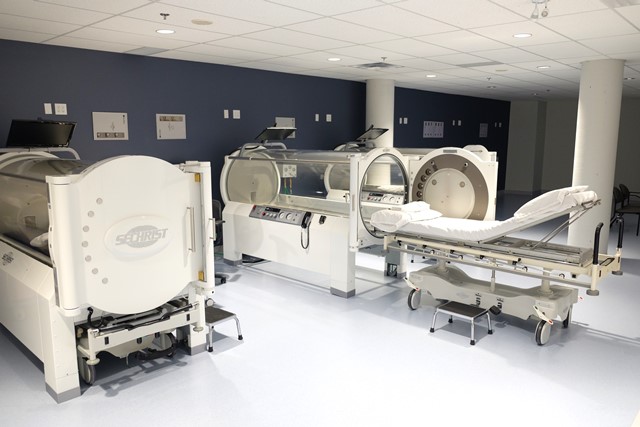By Dr. Anton Marinov
There are few conditions more disturbing, demoralizing and debilitating than complex non-healing wounds that persist for months, and sometimes years. The toll on the patients’ quality of life and the costs to the healthcare system are significant. According to the Government of Canada, the annual cost of wound care exceeds 3.9 billion. Morbidity is high. Diabetic foot ulcer patients, for example, carry a 3-year mortality rate of 26.4 per cent, and following amputation, the five-year mortality rate climbs to as high as 50 per cent.
Traditionally, the treatment of infected, chronic, or re-opened surgical wounds has been the domain of surgical debridement, infection control and meticulous wound care with frequent dressing changes. Advances, such as negative-pressure wound therapy and specialized wound dressings have had a positive impact, and are now among the most effective tools in wound treatment. Despite these gains, the most problematic wounds still fail to heal and it is here that hyperbaric oxygen therapy has gained popularity, as a treatment adjunct.
When Karen Trace, a resident of Scarborough, Ontario, walked through the doors of Rouge Valley Hyperbaric Medical Centre, she had been told by her doctors that her only option was to have an amputation. “Understandably, I was scared,” she later confessed. Not ready to settle, she approached the recently-opened hyperbaric medical centre, located in the medical building of the Scarborough and Rouge Hospital’s Centenary Site. “My doctor was aware of the treatment but cautious about how it would work for me. After consultations and several treatments, the wound completely healed and my foot was saved,” she went on. Karen is one of a growing number of patients who have benefited from hyperbaric oxygen.
Snake oil
There are few treatments less understood in the medical community than hyperbaric oxygen therapy. Having been in existence since the seventeenth century, it has been used for the treatment of a vast array of conditions. Today, the scientific evidence for many is lacking, but for a select few it is convincing enough to be approved by Health Canada and covered under the Ontario Health Insurance Plan. Complex wounds, diabetic foot ulcers, non-healing radiation damaged tissue, and compromised flaps and grafts are all approved indications for treatment with hyperbaric oxygen. The body of knowledge regarding the effects of hyperbaric oxygen has steadily grown and today we find ourselves in what can be best described as a renaissance in the field. Numerous in vitro and animal experiments have revealed that hyperbaric oxygen works by promoting tissue growth factors, drives the formation of new blood vessels, mobilizes stem cells from the bone marrow, and diminishes the inflammatory response. At the same time, clinical studies have revealed that hyperbaric oxygen can prevent amputations in select diabetic patients and result in savings to the healthcare system.
Hyperbaric practice today
Not long ago, perhaps ten to fifteen years, there were a handful of academic hospital-based hyperbaric centres scattered across the country – Halifax, Quebec City, Ottawa, Toronto, Hamilton, Vancouver. In recent years however, driven by the accumulated knowledge base and renewed public interest, new hyperbaric treatment facilities, such as the Rouge Valley Hyperbaric Medical Centre where Karen received her treatment, have opened their doors. The typical treatment is conducted in individual acrylic-walled chambers, where the patient breathes 100% oxygen at a pressure of 2 to 2.5 atmospheres for ninety minutes. The treatment regimen consists of a series of sessions, the number being determined by patient response and the indication for treatment. There are fourteen conditions currently approved by Health Canada. In addition to problem wounds the list also includes osteomyelitis, sudden hearing loss, burns, severe anemia, carbon monoxide poisoning, decompression sickness, necrotizing soft tissue infections, crush injuries and arterial gas emboli. In the majority of these conditions, hyperbaric oxygen is utilized as an adjunct to mainstream treatment. In the case of chronic wounds, this includes debridement, infection control, specialized dressings and offloading.
Future trends
Despite the advances in technology and science there is still much we do not know about this promising form of treatment. Dr. Rita Katznelson, a physician and researcher at the University Health Network is actively investigating the hyperbaric oxygen effects on patients suffering from stroke and those with spinal cord ischemia. Research from around the world is contributing to a growing body of evidence that hyperbaric oxygen can be helpful in other conditions ranging from traumatic brain injury and avascular hip necrosis to interstitial cystitis. National meetings of the Canadian Undersea and Hyperbaric Medical Association, are fostering deeper collaboration in clinical research. Meanwhile, the front line hyperbaric physicians and technologists at the Rouge Valley Hyperbaric Medical Centre along with their colleagues across the country are laying the foundation of modern hyperbaric medicine by outreach, education and evidence-based practice.
Dr. Anton Marinov is the Medical Director of the Rouge Valley Hyperbaric Medical Centre.


